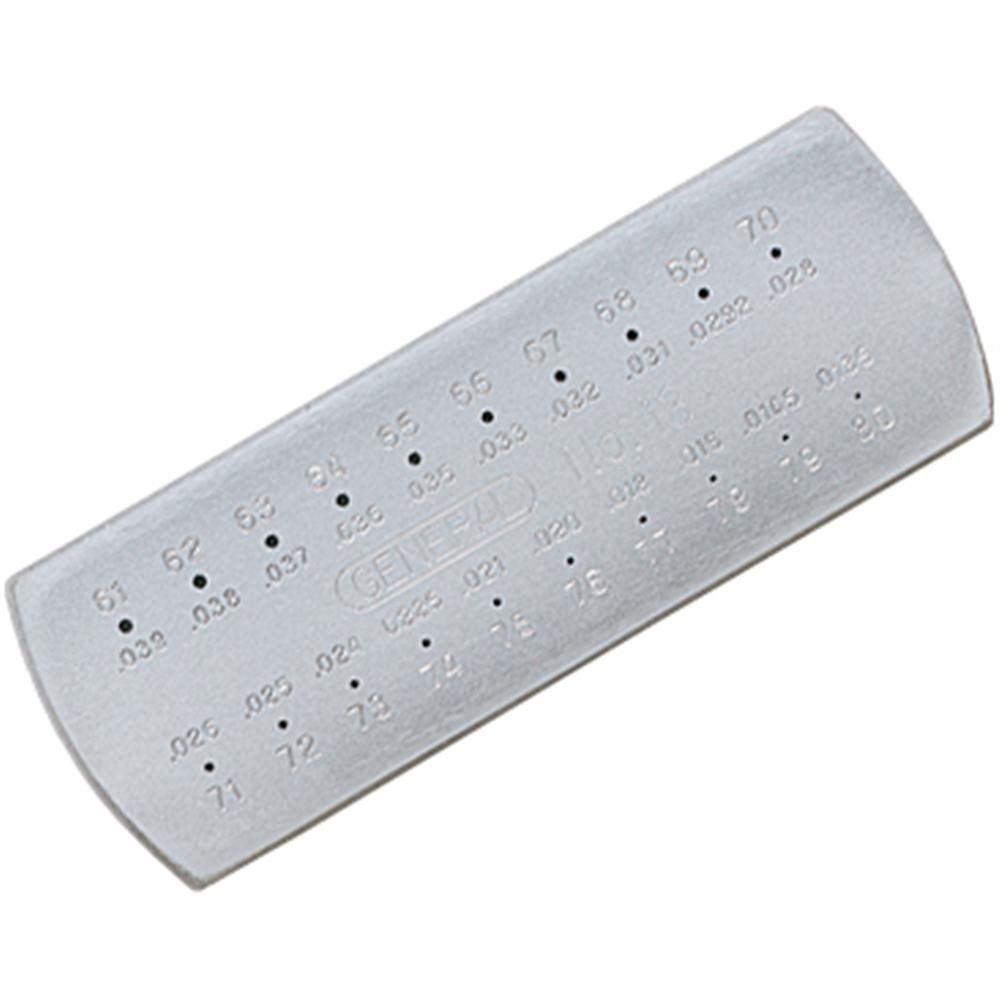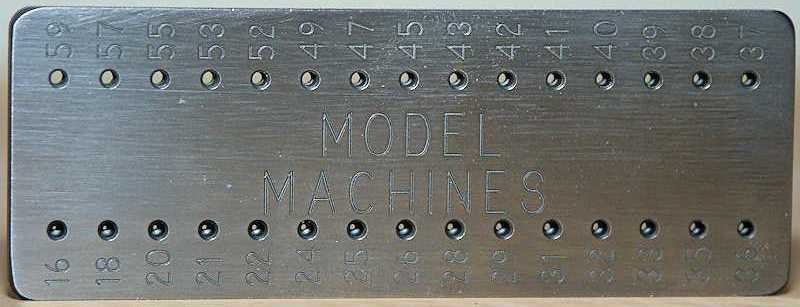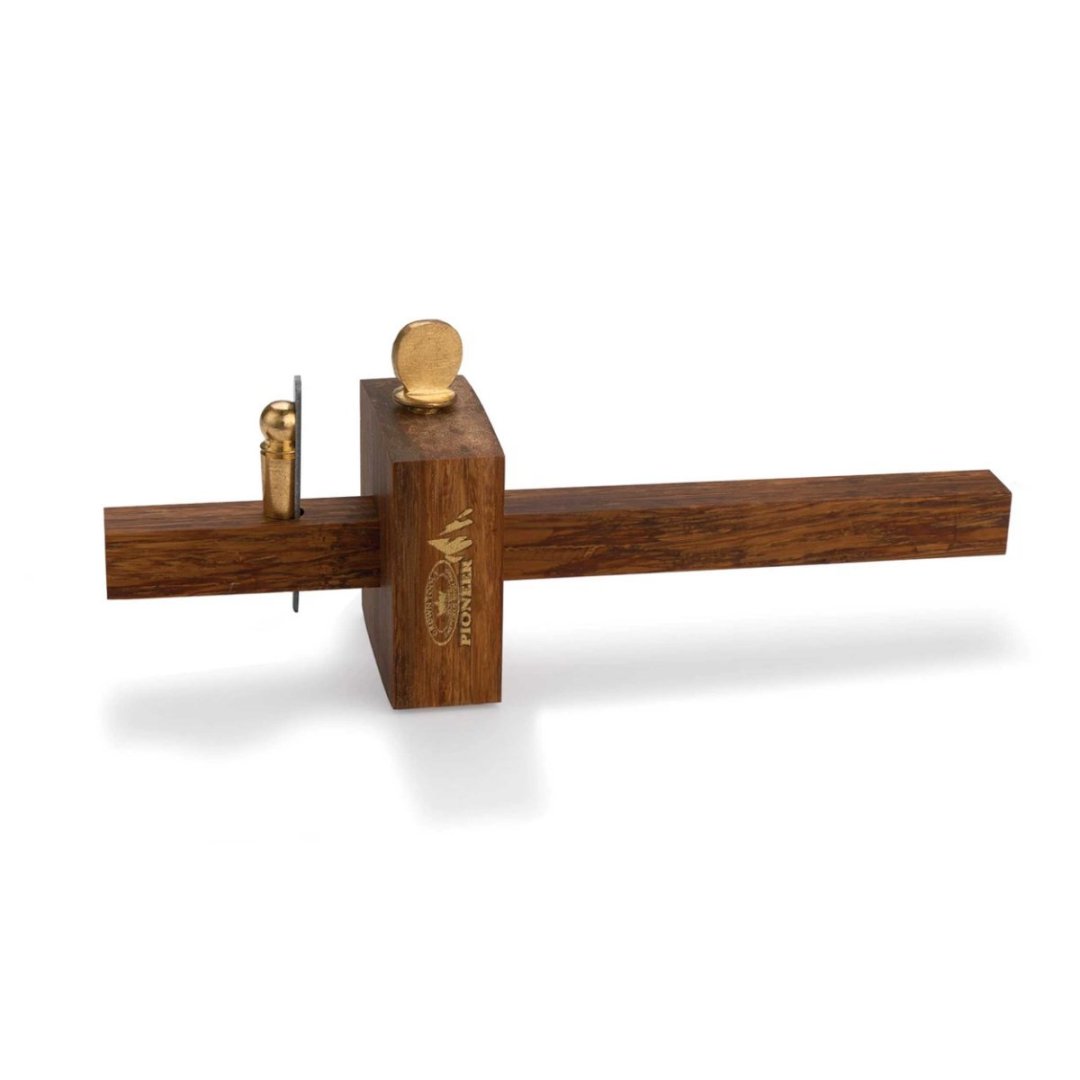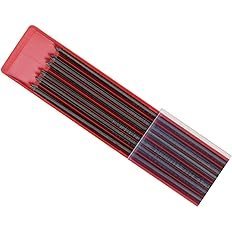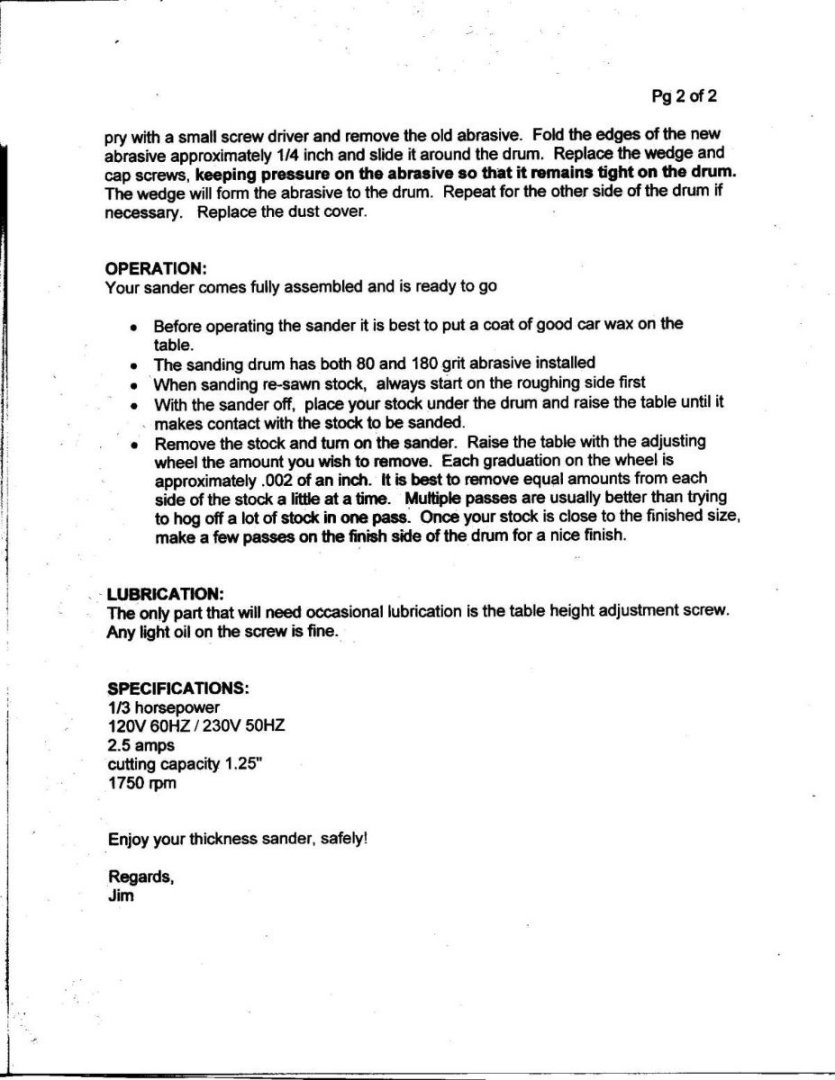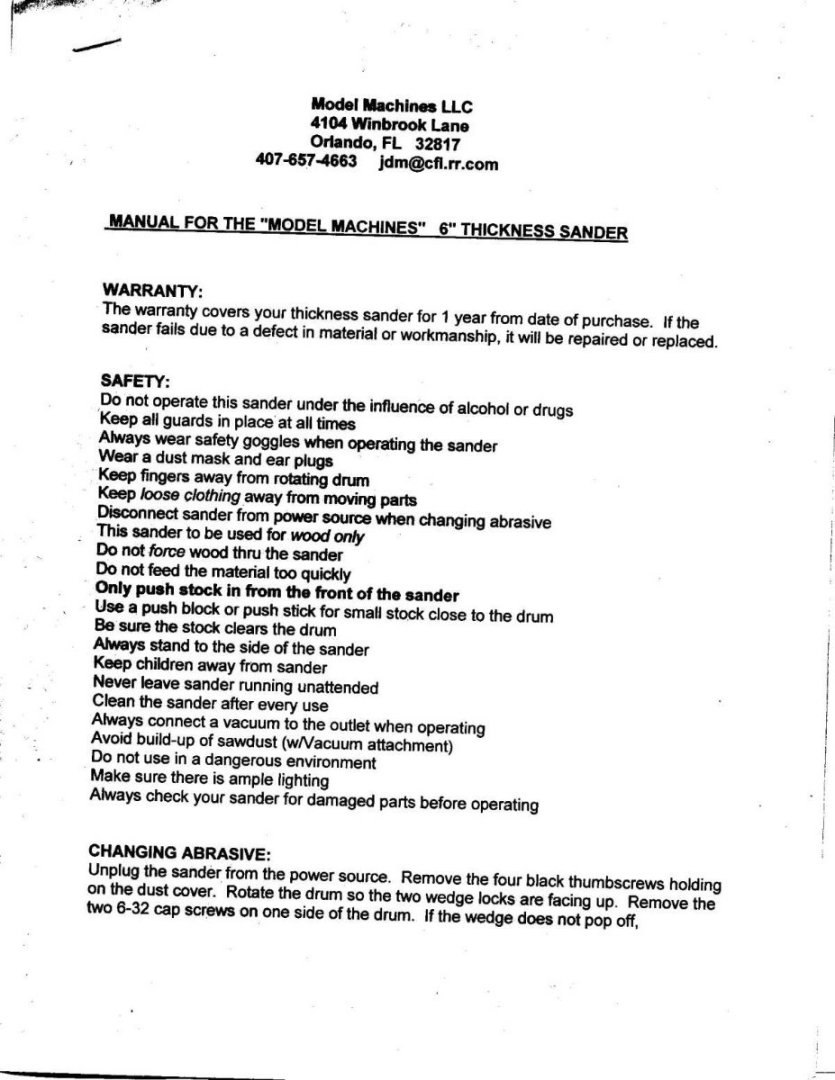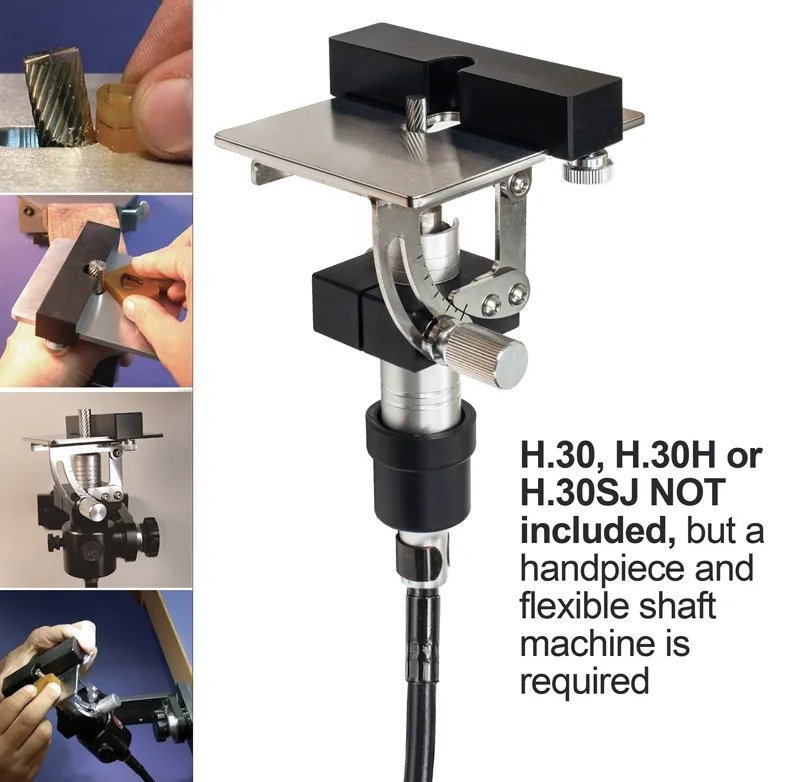-
Posts
3,084 -
Joined
-
Last visited
Content Type
Profiles
Forums
Gallery
Events
Everything posted by Jaager
-
It is a Jarmac. The ID label has been removed. It was made in a one-man shop in Springfield, IL. When the owner died, his shop died with him. It filled the small table saw niche during the time between the loss of the Unimat with its saw attachment and the JIM saw. The motor is probably a repurposed sewing machine motor - no power. It sorta worked with stock that was essentially veneer thickness. The fence was a welded bar - low - no adjustment. Simple miter gauge. Two tracks - so a home made sliding table worked for it. If you make a sliding table - about a full afternoon's time expense - it will be machine that fills the crosscut function that the recent chopper saw thread was all about. Note that the blade is a slotting blade - too many teeth for anything more than thick veneer. The companies that made reasonably priced blades that fit - Thurston and Martindale - no longer do. I think that there was a similarly T-ball league disc sander in the Jarmac line. Not really good, frustrating, but better than nothing if it was the only thing available. In my imagination, I can see this machine as a negative example for Jim.
-
Along with my premise that plastic may be a hindrance as an introduction to wooden ship model kits because of the difference in now the instructions relate (or how the older wooden kit instructions did). Unrealistic expectations because of the many different skills beyond just assembly and and that most of them are common to just about every kit. This gets repetitive and and excessive to do for every kit when there are "how to" books that do this. Looking at the above, I have another premise. A plastic kit is straight forward assembly. Additional knowledge about the anatomy and physiology of the object being assembled is not necessary. For a wooden ship model, it is important to have at least a basic knowledge of the individual parts and how they fit together. Knowing the proper names allows for an easier look up or inquiry about what is going on. Knowing what a proper keel, keel rabbet, stem, stem rabbet, hawse timbers (the first planking layer has to cover the purpose of the hawse timbers) the proper run of planking, would help with this specific problem. Faking it is not likely to yield a satisfactory product.
-
Rather than the vertical under the counter supports, why not mimic the original and use horizontal instead? I would worry that vertical may not fit well with the run of the planking. The upper part of the planking will run in almost the same axis. You could have flat filler pieces between the pseudo transoms with holes for dowels into the last mold. This would make a precise locator for each filler (reverse mortise) for almost idiot proof slots for the transoms. You could include a few Bamboo skewers as the dowels and burn holes that are their diameter. If you doubled up on each transom (two pieces instead of one in each slot) the planking would have a firm support. The planking will have serious bending and a firm base will have a better grab.
-

Instructions for rigging Cutty Sark
Jaager replied to bill mckee's topic in Masting, rigging and sails
I see the original volume is available on the second hand market Half of it covers masting and rigging I have the US reprint by Sweetman : CUTTY SARK, THE 1933 LONGRIDGE,C N EDWARD W SWEETMAN NEW YORK 1959 Make sure the loose plans are in the pocket. -
It is the same as drawing Bamboo trunnels. For years I have used General steel drill gauges 1-60 61-80 They work -I rub the reverse on a sharpening stone from time to time. Then there was one that works really well The Jim drawplate which I think is still available from http://www.byrnesmodelmachines.com/drawplate5.html The Bamboo skewers on the end caps are hit or miss as to which variety is in the bag. Some are soft and play nice but then to crush at the gripper and some are hard and brittle and fight you all the way. I have never seen drawplates for wood and I wonder if there is the necessary range of holes? I have jewelers drawplates, but they are more difficult to use - Thick with a cone on the reverse - it is a lot of work to get enough Bamboo thru the hole to have enough to grip and pushing does not work ar all
-
Things are not nearly a dire as they seem. Polaris is a double layer POB build. You are doing the first layer. The only function of the first layer of planking is to provide an adequate base for the actual planking. The molds on most POB kits are too widely spaced to provide support by themselves. Even though the first Italian kits termed them bulkheads, this is not what they are. Actual bulkheads are a feature of steel vessels and Chinese sea going junks. Western wooden ships did not have bulkheads. They are a mold of the cross section at their location. For that first planking layer - just good enough for the outer layer is enough. Gaps between strakes are not important. They do not need to be filled. If there are dips and hollows between the molds, these need to be fleshed out. Often a scab of wood does a better job than spackle if the dip is significant. If there is enough support for the outer planking, it does not matter what it looks like.
-
If you click on the Articles Database link at the top here and scroll down to the Framing and Planking section, the bottom three articles will show how the planking should be done. You do not have the materials to match what is shown, but this may give you a map for adapting as best can. Or you can buy wider and better replacement planking from a vendor at the right side of this page. You cannot spill an "S" shaped plank from wider stock with what is your kit supplied planking, Trying to edge bend to a serious degree is fighting the nature of the wood, so at least you should have some idea about the cause of your frustration. The garboard is the key to getting the rest of the planking to work out. For it, the edge opposite the keel should stay dead straight. Any removal should be at the keel edge and that should mostly be at the stem rabbet. Never bend the ends up the stem.
-

Fridericiana Alexandrina Navis, 1st century Roman Danube River boat
Jaager replied to dcicero's topic in Wood ship model kits
What with the epidemic of greed which defines the current era, there is a high probability that any plans would rival the kit in how much is the cost. If you have the materials and facilities to fabricate the model from its plans, the parts of the kit itself can be used as 3D plans for to fabricate a total replacement model using appropriate species of wood. Just a suggestion. -
I have an original version of the Dobson J never found a way to get satisfactory work out of it. The whole unit wants to move and rock when the blade is being used. After your comment, I can see that it being fixed to a large enough base solves that problem. It does greatly increase the real estate occupied by the device though. The blade is inside a sleeve and held vertical by two plastic screws - and I have not been successful in finding the sweet spot between a wobble and too much friction for the blade to slide easily. The grab helps cause the sliding and rocking. The stock wants to move back and forth with the blade. The brass wires for a hold down are too flimsy. It requires four hands. If fixed to a base, it is then down to three hands. I am not sure that razor saws models that allow for just the steel blade to be replaced are thin enough to fit the sleeve. This important because I have come to prefer a cut being on the pull stroke instead of the push stroke.
-
It is a bit more involved and depends on the era. Rope, rope and parrels, a wooden shoe, an iron truss and pivot spike. The yards on an actual ship need to pivot and swing on a horizontal plane. Often, the main yard was fixed at one spot on the mast. The upper yards would move up and down the mast. On a model, there are decisions. Sails or bare. Sails, and the topsail yards and above would be up. Bare = down. Sails would more often have the yards at an angle other than perpendicular. Bare = perpendicular. The way that the yards are attached to the mast needs to be simulated. But once the pose has been selected, the actual attachment of the yards can be some something as simple as a section of a brass pin in blind holes in the yard and in the mast. The simulation does not need to actually function. It is only on an RC model where the yards have to actually earn a living.
-
This is the old style marking gauge: Replace the steel scribing point with a section of a 2mm HB mechanical pencil lead Using scrap wood stock and a chisel a miniature version is easy to fabricate.
-

Did 18th and 19th century ships have flat weatherdecks?
Jaager replied to Rushdie's topic in Nautical/Naval History
I did not see a log with the deck being laid in process. It looks like there is a one piece sub deck on top of the molds and individual planks are laid on top. A deck curve should be easy to add. Use actual deck beams. Now the thickness would be much less than an actual deck beam. The middle would be the thickness of the deck crown, At the tops of the frames. At the side, the thickness would feather to zero. The wider this pseudo beam the happier you will be. This crowned deck would be done using- a shim that is an arc, actually, The old How To Build A Ship Model books show to get an arc or an ellipse over a distance. For the deck - to avoid creating a cartoon by over doing it: A touch of walnut aqueous stain or walnut acrylic paint added to the PVA on the plank edges should give you a scale appropriate caulking seam. No trunnels. Study up in planking butt shifts. A 4 butt shift with just a hint of a seam - not a wide -poke you in the eye bowling alley gutter seam. The grain makes doing a scratch for a cross plank seam difficult to pull off. I wonder if one of those ultra thin saws made from a razor blade would leave an even channel - not deep and filled with walnut PVA would do it? -
If there is a lamp assembly store near you - if that is still a thing - hollow brass cylinders of various sizes and shapes?
-
I would place money on the compounds that polymerize - the vinyl and acrylic components - have one chemical company as their origin. It is probably a toxic and hazardous process not cost effective to replicate in multiple locations. The gemisch that is the commercial product probably has a few more manufacturers but not as many as there are products. Some are just rebranded. If two companies have products in the same shaped dispenser, they probably come off of the same line. A line that forks just before the labeling machines. PVA when polymerized looks like intertwined fungal hyphae. The thinner the zone of just vinyl chains between two meeting surfaces, the stronger the bond. Clamping pressure = bond strength. The limiting factor is the amount of pressure the wood fibers can resist before they crush. If a POB build has molds that are plywood, it would probably be prudent to prime the areas that are end grain with pushed in and surface wiped PVA. Let it cure and then bond the planking.
-
I used Franklin pre-mixed Hide glue as a reversible glue. It holds too well the way I applied it. I coated both surfaces. I used tolerances that were too exact. Hide glue is a protein. Hot ethanol will denature it and have it curl into small balls. It would have been exactly what I want - if there was room for the hot ethanol to penetrate the glue joint. Hide glue is probably what the pre- 20th century models were assembled with. If your goal is a 100-200 year lifespan it should serve. The Franklin and Old Brown versions are convenient but the high percentage that is water is a worry. The glue pot hot dissolved flakes has much less water and would probably be the wise option. Offering a wide choice of critter origins for relative strength. It is however a witches brew process that takes addition time and skill before the actual wood joining step can begin. This lack of convenience is a difficult hurdle to justify when compared to just applying a bleb of Titebond II spreading it as a complete monolayer on both meeting surfaces. About Duco - it probably helps to read the directions. Totally coat both meeting areas - let dry - apply a wet layer and get together really sorta fast. It does hold better.
-

Blades for Artesania Latina Cutter
Jaager replied to brunnels's topic in Modeling tools and Workshop Equipment
Kurt is right. If chop is the way you wish to go Harbor Freight has a mini chop saw that will cut thru thicker stock rather than crushing the fibers It is Harbor Freight so it is not a Rolls. The table wants a layer to bring it up to the level of the bottom of the "vise". It wants to sling the off cut. You do not want your fingers as close to the blade as it would take to hold and prevent that. StewMac has a Japanese Curved-edge Mini Saw that I like - cutting on the pull stroke- good. -
-
@Bob Cleek Probably unintentionally glib above - I mean a thanks response With your contribution we have three apparatus that will potentially do the same job, two with a Dremel and two and maybe three with the Foredom - StewMac has a Foredom collet hand piece with threads that match the Dremel - if the Vanda-Lay is a tread mount - no custom fit is needed. The sobering factor is that a bevel of significant length is a rare function in my experience. My take home lesson from using the StewMac as a router - with a 220 drill bit tip as a cutter - to cut a keel rabbet - a hand chisel is the better way. Run-on thinking: Something like these could work to shape the "OG" type pattern on rails if there was an easy way to fix a flat cutter blade to a central shaft. But for all of the work to develop and shape and balance the tool, , hand scraping may be just as efficient.
-
No, I have not. I wasn't looking for the Wolf fixture either. I just thought that it might offer a possibility for someone. It is mostly to have it on the record and see what discussion came from it. I have a StewMac version that is a router - it becomes sorta like the above if rotated - but I would have to fake a fence. There are holes to mount one. Routers certainly take up a lot of pages in tool catalogs. I just have not found a need. They seem to be very fast, violent, and eager to eat more wood than is intended. I tried to use an under the table setup as an edger for my 8x4 rough, but failed to get a smooth face. My 10" tablesaw did a better job - burned a bit - but the result rides my bandsaw fence better than the sawmill face.
-
Wrong glue. PVA - yellow carpenters glue Titebond II if a display model Titebond III if it is RC No glue is going to bond all that well to end grain. Scrap wood - tongue depressors or Birch coffee stirs can be scabbed on both faces of the plywood molds where the planking bonds to widen and have better grain.
-
The main Foredom site with this is https://www.foredom.net/product/a-wt1728-wolf-adjustable-trimmer-for-wax/ The price is in the same ballpark. I have the TX motor since it is wood for its target and torque is needed rather than speed. I have matches if I want to start a fire. The prices associated with the GRS Benchmate vise system are a bit startling.
-
A different path - shellac. Half strength is an excellent primer - easy to wipe on - quick to dry - an excellent undercoat for just about anything. Scotch Brite (fine), tack, and then paint. As a finish coat - it does not have build up. The more coats, the more glossy. If a touch of linseed oil is added, it is what was French polish. Substituting Tung oil (pure - not something hinky like Homer's) worked for me. My suggestion is that you can get where you wish - with significant control and a reverse gear - if you use your present flat black and follow on with shellac - you can sneak up on your desired degree of gloss - by using multiple layers of shellac - Scotch Brite when each layer is dry - tack and wipe on another layer. Alcohol removes it if you dislike or go too glossy.
-
I see from picture #2 in post #25 - the idiosyncratic, bizarre, and distracting deck plank pattern - so often seen in OcCre product build logs: alternating butts on the same beam, stark contrast - highway width caulking, teacup diameter trunnels only at a butt joint - is not a misunderstanding on the part of beginning modelers? It is something that OcCre itself propagates!
-
Following up on email spam from Foredom - I found this tool - diverted into a wax shaping niche - it looks like it might work for various edge shaping jobs on wood. It has a grip zone that may work with a panavise-type mount. It could solve a bevel cut need - with a fence and a rotating table. Probably a hammer looking for a nail, but it looks neat.
-

Making lifeboat small mast for 1:200 Yamato
Jaager replied to Olaf's topic in Metal Work, Soldering and Metal Fittings
On Amazon, a productive search term is "brass Welding Wire Rods".
About us
Modelshipworld - Advancing Ship Modeling through Research
SSL Secured
Your security is important for us so this Website is SSL-Secured
NRG Mailing Address
Nautical Research Guild
237 South Lincoln Street
Westmont IL, 60559-1917
Model Ship World ® and the MSW logo are Registered Trademarks, and belong to the Nautical Research Guild (United States Patent and Trademark Office: No. 6,929,264 & No. 6,929,274, registered Dec. 20, 2022)
Helpful Links
About the NRG
If you enjoy building ship models that are historically accurate as well as beautiful, then The Nautical Research Guild (NRG) is just right for you.
The Guild is a non-profit educational organization whose mission is to “Advance Ship Modeling Through Research”. We provide support to our members in their efforts to raise the quality of their model ships.
The Nautical Research Guild has published our world-renowned quarterly magazine, The Nautical Research Journal, since 1955. The pages of the Journal are full of articles by accomplished ship modelers who show you how they create those exquisite details on their models, and by maritime historians who show you the correct details to build. The Journal is available in both print and digital editions. Go to the NRG web site (www.thenrg.org) to download a complimentary digital copy of the Journal. The NRG also publishes plan sets, books and compilations of back issues of the Journal and the former Ships in Scale and Model Ship Builder magazines.



.jpg.41c9ea636edabf5f1027e2d45ba8672a.jpg)
